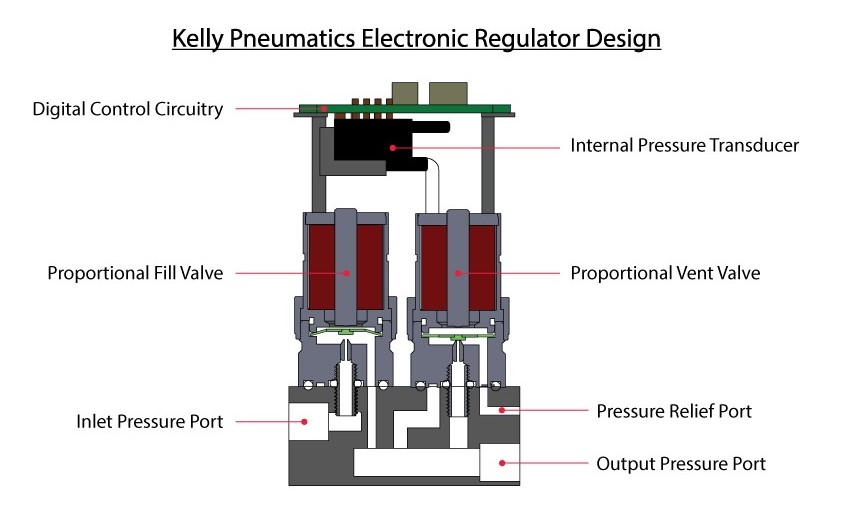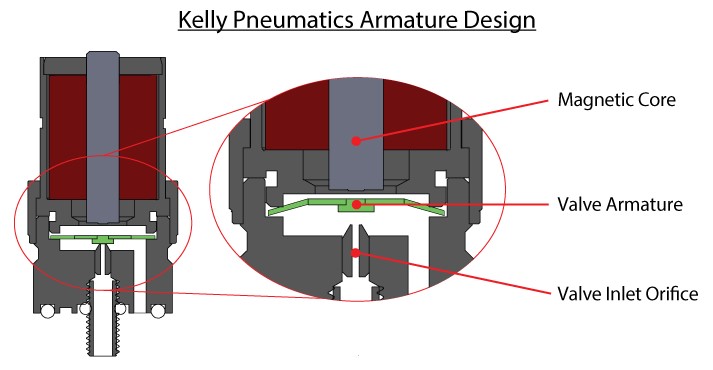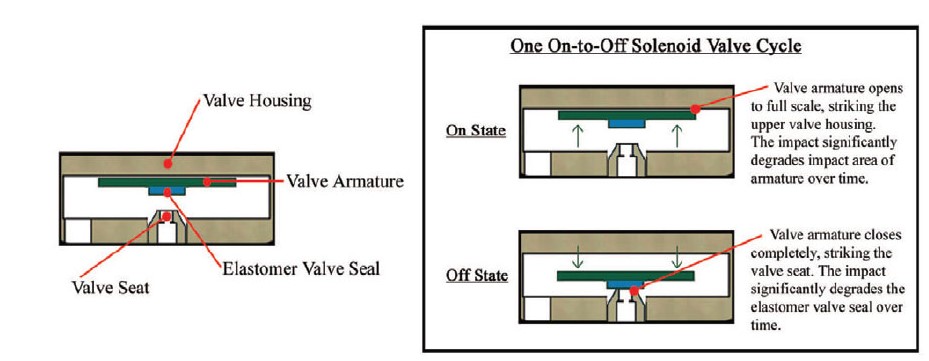Absolute Advantage: Proportional Valves for Pressure Regulation
By John Kelly, Engineering Manager, Kelly Pneumatics
For decades, electronic pressure regulators (or IP transducers) have been a staple of pneumatic control systems. Some electronic pressure regulators still use solenoid valves, but this can cause various issues in pressure control applications. Many of these issues can be solved by incorporating proportional valve technology as both flow inspiration (fill) and flow expiration (vent) for pressure control.
To better understand the advantages of proportional valve technology for pressure control, we need to consider the general properties of electronic pressure regulators and proportional-valve design.
Electronic pressure regulators have many advantages over mechanical regulators. A mechanical regulator maintains pressure downstream, most effectively with constant flow rates. However, downstream flow and pressure often fluctuate in most applications. Pumps and compressors deliver pulses, and the pressure fluctuates with demand. When a mechanical pressure regulator lacks accuracy or can’t respond fast enough, the result is uneven pressure output. This simple device might be good enough when accuracy isn’t as crucial. However, an electronic or digital pressure regulator delivers better accuracy and dynamic output pressure regulation by using a control signal and the feedback signal to create closed loop pressure control.
Electronic pressure regulators maintain a constant output pressure within a pressurized system even if there are fluctuations in the incoming pressure to the regulator. Mechanical pressure regulators are typically only adjustable by hand, limiting their usability in high-tech applications. When using an electronic pressure regulator with a digital control system, the precise output pressure is controllable via slight adjustments to the control signal. An internal pressure transducer creates a true closed loop control device and offers a feedback voltage of the current output pressure. By reading this feedback signal from an electronic regulator, control systems can make real-time adjustments, greatly improving consistent pressure regulation in the most demanding applications.
Electronic pressure regulators are a big improvement over mechanical regulators; they are fairly simple and effective at allowing better control. They use a fill valve and a vent valve to maintain the outlet pressure at the desired set point. A small internal pressure sensor monitors the output pressure, and the digital controller adjusts the flow output of the internal valves to retain the required set point (i.e., closed loop control). That means that when you set the desired pressure, the regulator maintains this pressure even with changing flow rates through the system. The internal pressure transducer gives immediate feedback to adjust the flow of either the fill or vent valve so the output pressure remains static.
When the control signal increases, the internal proportional valve activates, increasing pressure into an internal pilot chamber. When this happens, more of the inlet pressure passes through the proportional fill valve and into the pilot chamber. The pressure in the pilot chamber grows and causes the upper surface of the diaphragm to operate. Because of this, the air supply valve linked to the diaphragm opens, and a portion of the supply pressure becomes output pressure. This output pressure goes back to the control circuit using the pressure sensor. The fill valve continues to slightly adjust until the output pressure is equivalent to the desired set point of the control signal.
As we’ve shown, in standard electronic regulator design, using very accurate and fast fill and vent valves greatly affects the overall pressure control characteristics. But how do proportional valves achieve this?
Proportional valves
Traditional electronic pressure regulators typically employ a dual on/off valve design, with both an inlet and exhaust valve. Changes in pressure are controlled by cycling the on/off valves to open and close via pulse width modulation. Using pulse width modulation can be problematic for control systems for various reasons. Problems associated with using pulse width modulation of on/off valves and frequent valve cycling include a much shorter product life, product noise, control circuitry deadband, pressure oscillation, and inconsistent performance during dynamic output conditions.
Some pressure regulators incorporate an inlet proportional valve to compensate for these performance issues. However, these units typically use a single on/off solenoid exhaust valve to vent excess pressure and compensate for changing flow rates to the system. Typically, this is achieved with rapid valve cycling, so applications with dynamic output pressure rates are more susceptible to oscillation, as the exhaust valve must continually cycle at a rapid hertz to compensate for the dynamic pressure changes.


The critical component of a Kelly Pneumatics electronic pressure regulator is the dual proportional valve design. One valve controls the inlet and the other the exhaust; each valve proportionally increases or decreases the output pressure, respectively.
The incorporation of two proportional valves avoids many problems associated with traditional on/off valve regulators. This is mostly due to the inherent design of the proportional valves that control pressure regulation. Each proportional valve uses a single armature design, which offers virtually frictionless performance. Outlet pressure/flow is acquired by proportionally moving the single valve armature away from the valve inlet orifice. The total travel distance of the valve armature is only thousands of an inch. A slight increase or decrease in the armature distance from the valve orifice results in variable outlet flow rates and pressures.

Conversely, on/off valves do not typically offer variable flow rates and use an armature with a single calibrated travel distance. The valve armature during the off state is completely closed against the valve seat, while during the on states it is completely opened against the valve housing.
On/off valve cycling can be can be problematic when considering the aforementioned use of pulse width modulation in other pressure control units that must cycle valves at a particular hertz, which can substantially lessen the life of the solenoid valves being cycled and subsequently the product itself. This is especially true of applications with consistent outlet flow or frequently changing output pressures to the system when valve cycling is more consistent. Therefore, in many applications, valve cycling can be constant for these products, severely limiting product life. In the Kelly Pneumatics electronic pressure regulator, however, the internal proportional valves need only change their respective armature distance to change the output pressure and flow of the pressure controller. For example, when an increase of flow occurs downstream, the inlet proportional valve immediately adjusts to compensate by slightly adjusting the internal valve armature distance in a single movement. Additionally, during steady states, the proportional valves maintain the valve armature distance, with no wear to the valves themselves.
Using on/off valves for either fill or vent valves in pressure controllers can lead to problematic deadband in control systems. Due to the pulse width modulation of cycling on/off valves, this can cause rates of deadband in the control range at certain set points because the control algorithm may not calculate a small enough adjustment when cycling the fill and vent valves at particular frequencies. Since the proportional valves are able to finely adjust the internal armature height, fine tuning the output pressure is much more effective, preventing deadband for most set points and fine tune adjustments to the output pressure.
Using proportional valves also avoids the occasional pressure oscillations caused by pulse width modulated on/off valves. In static output conditions, the constant valve cycling of on/off valves can cause sudden missteps in pressure output with varying downstream flow conditions. These oscillations can affect applications that require constant output pressures over long periods between set point adjustment.
In comparison, any changes in downstream flow conditions are quickly adjusted for by the proportional fill and vent valves, since the internal valve armatures only need to make slight adjustment to the immediate armature position (oftentimes only thousands of an inch).
Another issue with using pulse width modulation is the audible sound generated by rapidly operating on/off valves. Many of these older designs with on/off valves for filling and venting must operate the valves at an oscillation in hundreds of cycles a minute, meaning that the valves have to fully close and open, generating audible clicking.
In contrast, since the proportional valve design does not require oscillation, there is no sound generated by the valves when changing flow outputs for either filling or venting. This is because the proportional armatures are adjusted through a single armature movement, rather than requiring a full on/off cycle.
Proportional valves for both fill and vent valves in electronic regulators offer huge improvements for pressure control. From extended product life, to improved accuracy and quieter operation, proportional valves in electronic regulators make all the difference.






